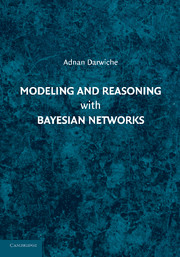Book contents
- Frontmatter
- Contents
- Preface
- 1 Introduction
- 2 Propositional Logic
- 3 Probability Calculus
- 4 Bayesian Networks
- 5 Building Bayesian Networks
- 6 Inference by Variable Elimination
- 7 Inference by Factor Elimination
- 8 Inference by Conditioning
- 9 Models for Graph Decomposition
- 10 Most Likely Instantiations
- 11 The Complexity of Probabilistic Inference
- 12 Compiling Bayesian Networks
- 13 Inference with Local Structure
- 14 Approximate Inference by Belief Propagation
- 15 Approximate Inference by Stochastic Sampling
- 16 Sensitivity Analysis
- 17 Learning: The Maximum Likelihood Approach
- 18 Learning: The Bayesian Approach
- A Notation
- B Concepts from Information Theory
- C Fixed Point Iterative Methods
- D Constrained Optimization
- Bibliography
- Index
15 - Approximate Inference by Stochastic Sampling
Published online by Cambridge University Press: 23 February 2011
- Frontmatter
- Contents
- Preface
- 1 Introduction
- 2 Propositional Logic
- 3 Probability Calculus
- 4 Bayesian Networks
- 5 Building Bayesian Networks
- 6 Inference by Variable Elimination
- 7 Inference by Factor Elimination
- 8 Inference by Conditioning
- 9 Models for Graph Decomposition
- 10 Most Likely Instantiations
- 11 The Complexity of Probabilistic Inference
- 12 Compiling Bayesian Networks
- 13 Inference with Local Structure
- 14 Approximate Inference by Belief Propagation
- 15 Approximate Inference by Stochastic Sampling
- 16 Sensitivity Analysis
- 17 Learning: The Maximum Likelihood Approach
- 18 Learning: The Bayesian Approach
- A Notation
- B Concepts from Information Theory
- C Fixed Point Iterative Methods
- D Constrained Optimization
- Bibliography
- Index
Summary
We discuss in this chapter a class of approximate inference algorithms based on stochastic sampling: a process by which we repeatedly simulate situations according to their probability and then estimate the probabilities of events based on the frequency of their occurrence in the simulated situations.
Introduction
Consider the Bayesian network in Figure 15.1 and suppose that our goal is to estimate the probability of some event, say, wet grass. Stochastic sampling is a method for estimating such probabilities that works by measuring the frequency at which events materialize in a sequence of situations simulated according to their probability of occurrence. For example, if we simulate 100 situations and find out that the grass is wet in 30 of them, we estimate the probability of wet grass to be 3/10. As we see later, we can efficiently simulate situations according to their probability of occurrence by operating on the corresponding Bayesian network, a process that provides the basis for many of the sampling algorithms we consider in this chapter.
The statements of sampling algorithms are remarkably simple compared to the methods for exact inference discussed in previous chapters, and their accuracy can be made arbitrarily high by increasing the number of sampled situations. However, the design of appropriate sampling methods may not be trivial as we may need to focus the sampling process on a set of situations that are of particular interest.
- Type
- Chapter
- Information
- Modeling and Reasoning with Bayesian Networks , pp. 378 - 416Publisher: Cambridge University PressPrint publication year: 2009



